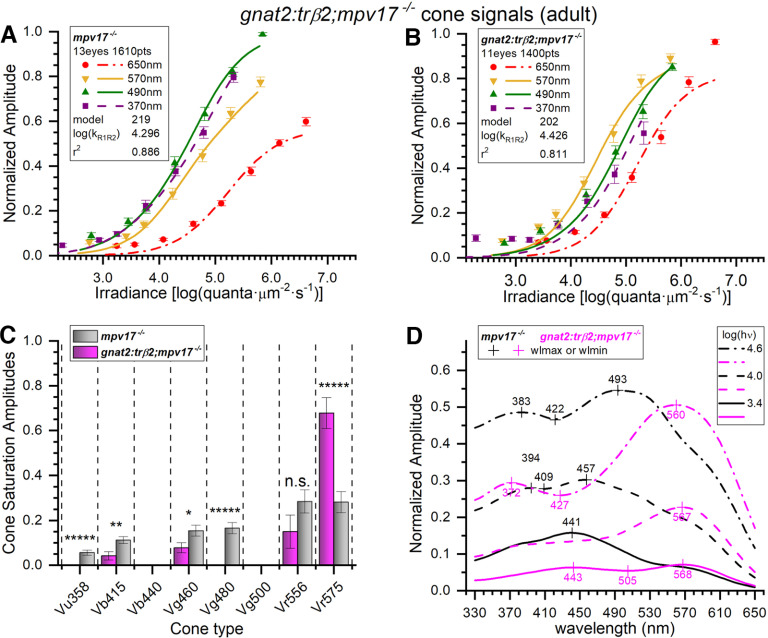Figure 10.
Adult spectral signals from gnat2:mYFP-2A-tr?2;mpv17?/? transgenics and mpv17?/? controls. A, Control (mpv17?/?) irradiance-response amplitudes and model curves at four wavelengths. The optimal model (#219) was fit to 1610 responses (all wavelengths) combined from 23 datasets taken from 13 eyecups. The 370-, 490-, and 570-nm amplitudes are means (ħSE), n = 23; 650 nm, n = 23 or 46. B, Irradiance-response amplitudes, and model curves, for gnat2:tr?2. The transgene shifts 370- and 490-nm irradiance-response functions from the left of the 570-nm curve (control) to the right of the 570-nm curve (transgenic). The spectral algorithm was fit to 1400 points combined from 20 datasets accumulated from 11 eyecups. The 370-, 490-, and 570-nm amplitudes are means (ħSE), n = 20; 650 nm, n = 20 or 40. C, In adult mpv17?/? control eyecups (gray bars), significant signals from six cone types were detected. Four were found in gnat2:tr?2 adults (magenta bars). Cone saturation amplitudes (Vmi, Eq. 1; Fig. 2A) are fractions of dataset maximum amplitudes (ħSE). Asterisks (or n.s., not significant) represent the significance of differences between control and gnat2:tr?2 cone signals (GraphPad Prism convention). Vu358 (UV, one-sample test): t(1579) = 4.81, p = 1.7 × 10?6; Vb415 (B1): t(2983) = 2.97, p = 0.0030; Vg460 (G1): t(2983) = 2.26, p = 0.024; Vg480 (G3, one-sample test): t(1579) = 6.59, p = 6.1 × 10?11; Vr556 (R2): t(2983) = 1.52, p = 0.127; Vr575 (R1): t(2983) = 4.87, p = 1.2 × 10?6. D, Adult spectral curves for mpv17?/? control and gnat2:tr?2 retinas. The transgene shifts sensitivity peaks to long wavelengths for all constant-quantal irradiances [3.4, 4.0, and 4.6 log(quanta·?m?2·s?1)]. A, B, The log(kR1R2) values are R1 or R2 cone semi-saturation irradiances in log(quanta·?m?2·s?1). A?D, Eight- to 18-month adults, 10 mm aspartate medium.

